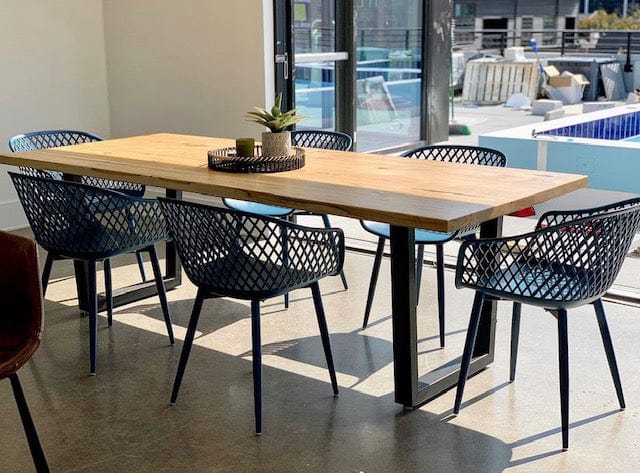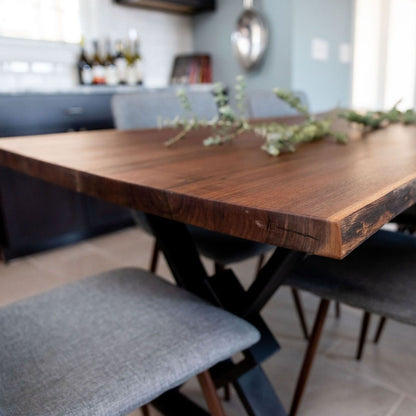How Dining Room Table Legs Can Change the Entire Aesthetic of Your Room
How Dining Room Table Legs Can Change the Entire Aesthetic of Your Room
Blog Article
From Typical to Modern: Discover the Ideal Dining-room Table Legs for Your Design
The option of dining-room table legs plays a crucial role in defining the overall personality of your room, bridging the void in between typical craftsmanship and modern aesthetics. While timeless styles such as cabriole and turned legs evoke a feeling of ageless sophistication, modern designs like barrette and geometric options offer an opportunity for striking aesthetic rate of interest. Evaluating the right balance between these styles calls for a nuanced understanding of your existing decor and individual taste. As you take into consideration these elements, the inquiry stays: how can you flawlessly incorporate these diverse leg designs to create a harmonious eating experience?
Recognizing Table Leg Styles
The selection of dining-room table leg styles can considerably influence both the visual appeals and functionality of the space. Each leg style adds distinct aesthetic components and useful attributes, providing to diverse style preferences and use demands. Understanding these styles is important for selecting the ideal eating table that aligns with your total interior decoration vision.
For example, conical legs provide a clean, classic look that can boost an area's elegance, while stand bases offer security and optimize legroom, making them ideal for smaller sized spaces. Barrette legs, a trademark of mid-century modern-day layout, present a commercial style, permitting a ventilated, open feeling. Trestle legs stimulate rustic charm, providing durable support and a feeling of timelessness.
Wood legs can bring heat and structure, whereas steel alternatives often communicate a streamlined, modern ambiance. Inevitably, comprehending table leg designs is vital for developing a natural eating location that mirrors individual design while guaranteeing usefulness and comfort.
Standard Table Leg Options
When choosing dining-room table legs, traditional choices commonly personify timeless sophistication and workmanship. These styles reflect an abundant heritage and a dedication to top quality, making them perfect for those who value timeless aesthetic appeals.
One of the most renowned standard leg styles is the cabriole leg, defined by its elegant rounded form. This design often features decorative carvings and is most frequently discovered in Queen Anne and Chippendale furnishings. One more prominent option is the turned leg, which flaunts a series of smooth, rounded forms that provide a traditional appearance while keeping stability.
Furthermore, the straight leg, while simple, offers a durable and unadorned framework that can mix flawlessly with a selection of tabletop styles. For those attracted to ornate describing, claw-and-ball feet legs stimulate a sense of splendour and can act as a stunning prime focus in any type of dining area.
Last but not least, pedestal bases, although not strictly legs, offer an alternative conventional choice that permits adequate legroom and can be wonderfully carved. Each of these traditional leg styles adds to the general setting of a dining-room, weding function with aesthetic charm.

Modern Table Leg Designs
Modern table leg styles use a varied variety of styles that stress clean lines and ingenious materials. These styles often prioritize capability while acting as striking centerpieces within a dining area. Minimalist looks are prevalent, with legs crafted from materials such as steel, glass, and crafted wood, which contribute to a contemporary and ventilated feeling.
One prominent layout is the barrette leg, defined by its slim, conical framework that offers stability without frustrating the table top (dining room table legs). This style is typically discovered in mid-century modern furniture and can easily match different browse this site dining table forms. Another fad is making use of geometric forms, where legs might tackle angular or asymmetrical types, adding visual rate of interest and a touch of creativity

Blending Designs for One-of-a-kind Spaces
Usually, house owners seek to produce distinct dining rooms that reflect their personal style by blending numerous design elements. This technique permits for the unification of diverse appearances, causing a harmonious yet unique environment. Combining a rustic wood table with sleek, modern-day metal legs can produce an appealing comparison that elevates the area's overall appeal.
Furthermore, incorporating vintage table legs with contemporary table tops can evoke a sense of background while maintaining a contemporary perceptiveness. Such mixes not only showcase specific taste but additionally motivate imagination, permitting house owners to curate an area that really feels both individual and inviting.
Shade plays a critical role in this blending procedure; choosing table legs that match or contrast with the existing color pattern can enhance visual rate of interest. Whitewashed legs can soften the daring of a dark table surface, creating a well balanced visual.
Tips for Picking the Right Legs
Picking the right table legs is necessary for attaining both functionality and aesthetic charm in your eating space. Begin by considering the general design of your space. Traditional setups take advantage of legs that include intricate carvings or turned layouts, while contemporary spaces might require streamlined, minimal designs.
Next, official site analyze the height and security of the legs. dining room table legs. Standard eating tables range in between 28 to 30 inches in elevation, so ensure the legs enhance this measurement for convenience. In addition, durable materials, such as wood or metal, can improve security and long life
Examine the leg shape too-- choices consist of right, tapered, or pedestal layouts. Straight legs use a timeless appearance, while conical legs can add a touch of sophistication. Pedestal bases provide enough legroom and are suitable for smaller spaces.
Conclusion
In recap, choosing the optimal dining-room table legs calls for cautious factor to consider of both modern and standard designs. Standard options such as cabriole and turned legs supply ageless sophistication, while contemporary styles like hairpin and geometric forms give Web Site a contemporary touch. By integrating leg design, height, and material with the total décor, a cohesive and inviting environment can be achieved. Inevitably, the picked table legs must mirror the wanted aesthetic, improving the eating experience within the room.
The range of eating space table leg designs can substantially influence both the visual appeals and capability of the area. Eventually, comprehending table leg designs is essential for producing a natural dining location that shows individual design while making sure usefulness and comfort.One of the most legendary typical leg styles is the cabriole leg, characterized by its stylish curved shape. Straight legs use a traditional appearance, while conical legs can include a touch of elegance.In recap, choosing the perfect dining area table legs requires cautious consideration of both modern and traditional designs.
Report this page